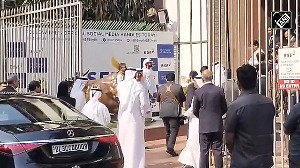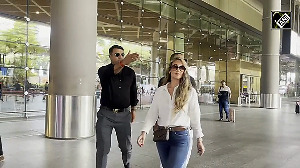The name is Bond -- the spy who effortlessly enters secret laboratories and saves the world from nuclear destruction. But how does James Bond manage to slip in unnoticed?
He needs more than just a key or password. He needs to have either the villain's irises (the pigmented, round membrane of one's eye), voice patterns or finger imprints - or maybe all of them together - to get access to the inner chambers. Bond succeeds in doing so - but all that in films. Can he do it in real life?
Why not? It may come as a surprise to some that the world over, airports, hospitals, hotels, grocery stores and even Disney theme parks are already imitating Bond in many respects - they're using technology that identifies you based on your physical or behavioural traits for added security.
It's known as Biometrics. The five most common commercialised biometric technologies (globally) are fingerprint (39 per cent), hand (31 per cent), voice (16 per cent), face (7 per cent) and eye (4 per cent), according to industry reports. However, the mix is bound to change significantly over the next couple of years.
Industry gurus are convinced that biometric solutions might just be the answer for increasing number of data and identity thefts. Captain Raghu Raman, CEO, Mahindra Special Services Group opines, "A biometric authentication, I feel, represents the new plus ultra of the existing authentication methods." Alekhya Talapatra, country manager, Defence & Security, Technology Solutions Group, HP India seconds Raman's outlook.
While "one has to keep changing passwords time and again so that no one breaks into your system", he believes that biometric applications are better security options because of their unique identification and authentication measures.
"Physical attributes are much harder to fake than identity cards. One cannot guess a fingerprint pattern the way you can try to guess a password. Besides, you cannot misplace your fingerprints, irises or voice the way you misplace an access card. Above all, one does not have to remember innumerable passwords," reasons Sapna Capoor, industry analyst, Biometrics Group, Frost & Sullivan.
Ross Wilson, managing director (South Asia and India), RSA Security makes a point citing cases of data recovered from second-hand laptops, PCs sold on a leading online auction site.
"Data, thus recovered, contained HR (human resources) databases of Fortune 500 companies. This kind of information is explosive and very sensitive in nature." He reckons, desktops/laptop vendors need to invest in smartcard-biometric combo readers and cards to store the biometric credentials.
"The power that fingerprint authentication provides the user in one finger is much more than what a hacker can do with 10," says Sanjeev Menon, GM (Products), Lenovo India. Lenovo claims to have sold more than 1,000,000 ThinkPad notebooks, which come with an integrated fingerprint reader. The PC vendor estimates that password resets account for 35-50 per cent of all helpdesk calls.
The cheapest answer, according to Tim Best, business development director (e-identity solutions), LogicaCMG, are that fingerprint scanners would serve as a good kick-off point for India. "Bulk of the consumer goods have started adding fingerprint scanners, whose prices have fallen dramatically. It adds as little as $ 50 to the price of a laptop."
Capoor agrees and adds, "Cost of these solutions would become more relevant weighing the volumes afforded by countries like India." A biometric solution (a fingerprint reader or a voice identifier) can add anywhere between Rs 1500-3500 to the actual cost, while face and iris scanners are still expensive with prices above Rs 100,000.
"We must not begin with asking the question 'Which Biometric technology is best?' as there is no ideal biometric solution for all applications; it all depends on what you are trying to achieve, with whom and under what conditions," believes Shlomi Yanani, vice president (eToken business), Aladdin Knowledge Systems.
There is the fear that biometrics, especially fingerprinting, is not unbeatable. Statistically speaking, a fingerprint analysis is 98-99 per cent accurate. So, if one in every 100 or say 1000 people have common or identical finger print pattern, then in a nation of 300,000,000 million the rate of identical prints are a disastrous proportion.
Some biometric solution manufacturers are now playing with seemingly far-fetched devices that purport to identify people by the shape of their ears, their walk or their smell. Ken Nakazawa, division head (IT), Sony India, emphasises the need to create an awareness about security hazards.
"Many people are inclined to think 'oh, that won't happen to me, I don't need that extra security.' As the saying goes, 'Seeing is believing,' in this case it will too late if 'experiencing becomes believing,'" he rues.
Yet the world is full of true believers who see biometrics changing the future. "If you are looking for a positive identification or verification, it is the best technology," sums up Nakazawa.
Analysts' forecast - by 2008 the fingerprint scan and voice verification segments promise steep growth rates followed closely by the facial recognition and eye scan technologies sectors. "The first movers on to this bandwagon in India will be the MNCs," is how Talapatra sees it happening.
The promise of improved security with biometric technology is comforting. However, the debate over biometric security will - and should - continue.
Why is Biometrics important?
- Information cannot be lost, stolen or forgotten
- Users are not required to present a card or to remember passwords or PIN numbers
- Organisations can verify users' identities with a high degree of confidence when used in conjunction with smart cards
- Overheads associated with password management are eliminated
- How big is the Biometric industry?
- The biometrics market will be $ 205 billion by 2006 as against $ 93.4 million last year
- Wireless silicon chip fingerprint market in 2005 was pegged at $ 26 million (world over) and is expected to touch $ 629.4 million by 2011
- Voice verification markets totaled $ 31.6 million in 2004 and will touch $ 533.7 million in 2011







 © 2025
© 2025